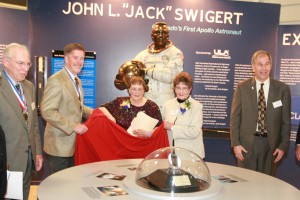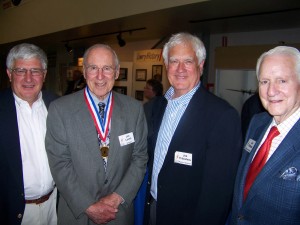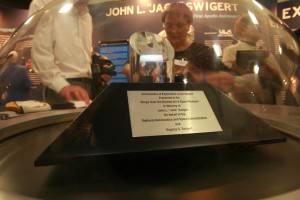
Apollo 13 commander Jim Lovell said Jack Swigert was a vital element of the safe return of their crew.
By Reggie Paulk
On Friday, May 23, NASA presented the Ambassador of Exploration Award—a piece of moon rock encased in Lucite—to the sisters of the late Apollo 13 astronaut John “Jack” L. Swigert Jr. The award will be on permanent display at the Wings Over the Rockies Air and Space Museum as part of a new exhibit, “Colorado Astronauts—In Their Own Words.”
Apollo 13 Commander James “Jim” Lovell and Scott Carpenter, one of the original Mercury Seven astronauts, were on hand at the museum to help present the award. Also attending were a number of astronauts from the current space shuttle program.
Carpenter was the fourth American to fly in space and second to orbit Earth. During his five-hour flight aboard Aurora 7, he orbited Earth three times, performing science experiments and other duties.
A Colorado native, Carpenter spoke for Colorado astronauts, talking about the driving force behind spaceflight in the ’50s and ’60s.
“In the early days, one of the most powerful forces was the belief on both sides of the Iron Curtain that preeminence in space was a condition of our freedoms,” he said. “I think the competition between the Soviets and us fostered the avoidance of a shooting war and brought about the end of the Cold War.”
We don’t have the Soviet Union to foster that same sense of competition, but Carpenter gave some insight into the future.
“It’s important to realize two things,” he said. “The competition lies in wait. That’s a good thing. And China lurks. That’s a good thing too.”

Mercury Seven astronaut Scott Carpenter said the Chinese will be our greatest competition in the future of space exploration.
Capt. Jim Lovell, commander of Apollo 13 during its fateful voyage, said that the award and the exhibit would be further recognition of the contribution Jack Swigert made to the exploration of space.
“I hope that inspires many young people who come through the museum to follow similar careers,” he said.
Lovell’s regard for Swigert is obvious.
“I didn’t know Jack during his early days, but I did know him at the time that was most critical to our lives,” Lovell said. “As part of the support group for the Apollo program, he did most of the compiling of the malfunction procedures for the Apollo command module. Not until later did I realize how important this knowledge was to the successful recovery of 13.”
Even though Swigert, a Colorado native, was on the backup team, he still worked very closely with the primary crew. Because of this, all of the crewmembers were able to get to know each other quite well. It wasn’t until the last month before launch that the two crews pulled apart, with the backup crew taking on social responsibilities while the primary crew took over the simulators.
“Everything worked fine until three or four days before the flight when Charlie Duke came down with the measles,” Lovell continued. “Ken Mattingly had never had the measles. Everybody thought he would come down with them while orbiting above the moon, alone in the command module, as Hayes and I were on the moon’s surface.”
He explained that Swigert was chosen as command module pilot for Apollo 13. Lovell also dispelled a myth created by the movie.

L to R: Jim Lovell, astronaut James Reilly, Virginia Swigert, Betty Barube and Greg Anderson are all smiles, after removal of the shroud that covered the lunar sample.
“Contrary to the movie, Swigert was a very competent pilot,” Lovell said. “The movie makes it look like he had to earn his wings every day because he hadn’t been training for over a month. That wasn’t correct. He was very competent—just a part of the crew.”
Lovell relayed a couple of funny anecdotes about his friend while aboard the doomed flight. As a CM pilot, he had never been in the lunar module until the emergency.
“Jack was a big fellow and he liked to stretch out,” Lovell remembered. “We failed to tell him how this lunar module was constructed, until we saw him put both feet on the wall, which was the hatch you’d go out to get onto the lunar surface. He started to stretch and it began to bend a little bit. The skin of the lunar module was so thin that you could probably put your fist through it if you wanted, so we said, ‘Jack, please take it easy. You have to be very careful about doing anything around here.'”
As the CM pilot, Swigert was responsible for powering it back up when they began to approach Earth.
“We had powered down everything,” Lovell recalled. “The guidance system was turned off. We lost all of our memory, as to our attitude with respect to the celestial sphere. We were afraid it would freeze up if we weren’t too careful. Well, Jack got the procedures and slowly but surely, being exhausted and cold, got the CM back up again. He did an outstanding job in a time of peril.”
Lovell’s final comments echo his feelings for his comrade.
“I think it’s appropriate to place this lunar rock and this Ambassador of Exploration Award at an aerospace museum where it will be a legacy to the career of Jack Swigert,” he said.
Accepting the award on behalf of her brother, Swigert described what it was like to be the sister of a future astronaut.

L to R: Ron Knudson, NASA astronaut Jim Lovell, Joe Thibodeau and Carl Williams visit during the event.
“Growing up with Jack was a neat experience,” she said. “Jack was daring and smart. From building his own hot rod to studying parachute theory and jumping off a two-story garage, breaking his ankle, he kept Mom and Dad going. As a result, Betty and I were the angels of the family.”
Swigert’s sister, Betty Barube, relayed a little more about her brother’s personality.
“When Jack and Virginia and I were growing up, the term ‘gifted child’ hadn’t been coined yet,” she said. “I think through experience, he was able to channel his curiosity, intelligence and his daring to perform many feats.”
Swigert died of cancer in 1982, but his legacy lives on in the hearts and souls of all people who dream of things bigger than themselves. A statue of Swigert stands prominently in the new display alongside a sample of the moon rock carried back to Earth by intrepid explorers just like him.
For more information about the new exhibit, visit [http://www.wingsmuseum.org].












